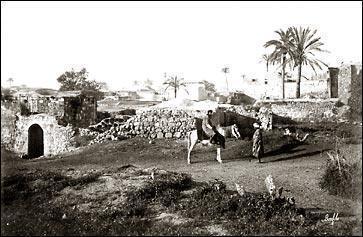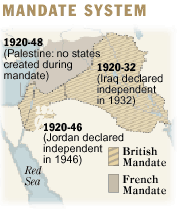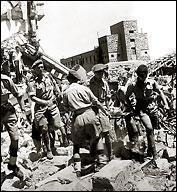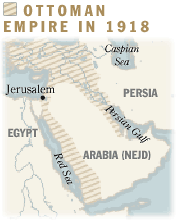
Sunday, May 12, 2002
The revolts
Zionism and Arab nationalism
The push for Jewish and Palestinian nations arose primarily in the late 19th and early 20th centuries. In all the talk of ancient hatreds and religious feuds, it is easy to lose sight of this basic fact: The concepts for states of Palestine and Israel as we now understand them are younger than even the concept of America.
 |
 |
| MICHAEL MASLAN / CORBIS |
| 1870s Palestine: A man stands near a horse and rider in ancient stone ruins near the town of Lydda. Zionist Jews fleeing persecution in Europe and Russia would soon begin arriving in the area in increasing numbers, raising tensions with the Arabs. |
|
 |
PALESTINIAN IDENTITY
For the people who would become the Palestinians, the seeds of a strong national identity began in the early 1800s with struggles against the ruling Ottomans, who had controlled the territory since the 1500s, and in 1834 against the Egyptians, who for a short time ruled the area. These revolts, and later revolts against other outside powers, unified Arabs from diverse backgrounds — peasants, urban traders, religious leaders — by pitting them against common enemies.
When Zionist Jews fleeing persecution in Europe and Russia began arriving in increasing numbers in the 1880s, the influx of immigrants raised tensions. A series of confrontations between Jews and Arabs began in 1920. When the British, who voiced support for Zionism, won control of the area after World War I, there was a major Arab revolt against them, too.
 DID YOU KNOW ... A Semite is a person descended from Shem, Noah's son. The meaning can be expanded to include any people speaking a Semitic language, including Hebrews, Arabs, Assyrians, etc. Hence, Arabs as well as Jews who are descended from Middle Eastern roots are Semites. It also means some Jews are not Semites. The term anti-Semitic, however, was used in the late 1800s in Europe to mean hating Jews and has held that meaning since.
DID YOU KNOW ... A Semite is a person descended from Shem, Noah's son. The meaning can be expanded to include any people speaking a Semitic language, including Hebrews, Arabs, Assyrians, etc. Hence, Arabs as well as Jews who are descended from Middle Eastern roots are Semites. It also means some Jews are not Semites. The term anti-Semitic, however, was used in the late 1800s in Europe to mean hating Jews and has held that meaning since.
|
|
|
 |
RISE OF ZIONISM
For Jews, the longing to return to the Holy Land had been a unifying force for thousands of years before the creation of the Jewish state.
"Next year in Jerusalem." These words are spoken annually by Jews during Passover, the holiday that commemorates the Israelite exodus from Egypt. The prayer reflects the longing of an exiled people to return to their first land, a home they believe was given to them by God.
In the late 1880s Jews faced rising anti-Semitism in Europe and violent pogroms in Russia. A few decades later, 6 million Jews died in Adolf Hitler's Holocaust. Because of all this, the idea of Zionism — the establishment of a Jewish state — gained widespread support among Jews.
THE BRITISH MANDATE
The British were given a League of Nations mandate over the former Ottoman area they called Palestine after World War I.
Frustration of the Jews and Arabs of Palestine grew as they saw no sign of imminent statehood under the mandate. Other Arab areas were granted statehood, but Palestine remained under mandate control. Jews and Arabs clashed with each other and fought the British almost immediately.
In 1936, the Arabs began a major revolt against British policies and ever-increasing Jewish immigration. The revolt ended in 1939, the same year the British released a document known as the White Paper of 1939, which limited Jewish immigration to Palestine to 75,000 over five years — and none thereafter. It also prohibited future land sales to Jews, and promised Palestine independence within 10 years, presumably as an Arab-dominated state.
As tensions between Arabs and Jews became increasingly volatile and the enmity both groups felt toward the British escalated, the British mandate became ever more tenuous.
THE U.N. PARTITION
In 1947, Britain told the United Nations it was ending the Palestine mandate and handed the problem to the United Nations.
A U.N. commission recommended that Palestine be partitioned into two states, one Arab and one Jewish, with Jerusalem under international control. The United States supported that idea. The recommendation was endorsed by the U.N. General Assembly on Nov. 29, 1947 as U.N. Resolution 181.
The Arab states and the Arabs of Palestine rejected the U.N. partition, feeling that all the land was theirs. The Jews accepted the plan and on May 14, 1948, led by David Ben-Gurion, declared statehood for Israel. U.S. President Truman recognized Israel immediately, followed shortly after by the Soviet Union.
Israel was attacked the next day by the Arab states and Palestinians.
What followed was the first major Middle East war over the conflicting national aspirations of the Jews and Palestinians.

WORLD WAR I MANEUVERING
The political maneuvering by the Allies surrounding the breakup of the Ottoman Empire after World War I set the tone for the Israeli-Palestinian conflict throughout the 20th century.
 |
The mandate system was developed by the League of Nations as a way for member nations to govern lands conquered by member nations. The League gave Britain and France mandates to govern Ottoman territories in the Middle East after World War I.
 |
|
 |
In 1915, Sir Henry McMahon, on behalf of Britain, told Sherif Hussein, head of a ruling Arab family, that Britain supported Arab control in the region after the Ottoman Empire breakup.
The British later were to argue that the letter was worded in a way that omitted Palestine from that territory; the Arabs would say that was not the proper interpretation of the letter.
The secret 1916 Sykes-Picot Agreement, between Great Britain's Sir Mark Sykes and France's Georges Francois Picot, provided for international control of the Middle East. France was to rule much of the north, including Syria and Lebanon, and the rest of the area would be under Britain's control.
In 1917, Britain's Lord Arthur Balfour signed a declaration that proclaimed the right of the Jewish people to a national home in Palestine, while at the same time respecting the rights of non-Jews in the area.
The Sykes-Picot division and the wording of the Balfour Declaration were written into the League of Nations' British Mandate for Palestine, which was set up in 1920 and formalized in 1922.
Over the next 45 years, Arabs would gain statehood in all the areas but Palestine.
The seemingly contradictory positions by the British — promising statehood for both Jews and Arabs — is seen as an effort to win the support of both groups in Britain's fight against the Ottoman Empire.
|
 |
 |
 |
THE KING DAVID HOTEL ATTACK
After World War II, Jewish underground forces stepped up their activity, attacking the British in Palestine with the intent of driving them out. In response to a series of attacks, the British in 1946 arrested some 1,000 Jews and confiscated reams of documents from the Jewish Agency, the office that represented the Jews to Britain.
 |
| ACME / HULTON GETTY PHOTO ARCHIVE |
| King David Hotel: British troops carry a casualty out of the Jerusalem building after a 1946 blast that killed 91 people. |
In retaliation, the Irgun, one of the Jewish underground organizations, led by future Israeli Prime Minister Menachem Begin, planted bombs at the British headquarters in Jerusalem's King David Hotel. Begin, in his memoirs, says three telephone calls were made to warn of the bombs, but the hotel was not evacuated. The blast killed 91 people, including Britons, Jews and Arabs, and injured 45 others.
|
Copyright © 2002 The Seattle Times Company
|
 |

1843
|
| |
First Zionist writings by Rabbi Zevi Kalischer. Zionism, the concept of a home for Jews in the Holy Land, would gain impetus through the century.
|
1882
|
| |
12,000 refugees from Russian pogroms go to Palestine in the First Aliyah, or wave of immigrants to Israel.
|
1895
|
| |
Theodor Herzl writes "The Jewish State," proposing a Jewish homeland.

|
1901
|
| |
Jewish National Fund is founded to buy land in Palestine for Zionists.
|
1904
|
| |
Jews escaping pogroms in Russia and Poland form Second Aliyah.
|
1914
|
| |
World War I begins.
|
1916
|
| |
Sykes-Picot Agreement.
|
1917
|
| |
Balfour Declaration.
|
1918
|
| |
World War I ends. About 60,000 Jews live in Palestine, 10 percent of total population.
|
1919
|
| |
Palestinian Congress advocates incorporating Palestine into Syria.
|
1919-1921
|
| |
20,000 Jewish immigrants from Russia and Poland create Third Aliyah.
|
1920
|
| |
League of Nations grants Britain and France mandates to govern former Ottoman land in the Middle East.
|
1921
|
| |
Britain divides its mandate, creating Transjordan east of the River Jordan and leaving the land west as Palestine. British take first census of Palestine — 84,000 Jews are 12.9 percent of the population.
|
1924-1930
|
| |
Fourth Aliyah brings 80,000 more Jews to Palestine. Arabs number about 700,000.
|
1929
|
| |
The Irgun, a Jewish guerrilla army, is formed; one future leader will be Menachem Begin.
|
1929
|
| |
Arab riots against Jews over rumors, spread by Arab leader Haj Amin El-Husseini, that Jews want to build a synagogue at the Western (Wailing) Wall.
|
1930-39
|
| |
Jews flee Hitler, swelling the Jewish population in Palestine to about 350,000.
|
1936-1939
|
| |
Arabs intensify riots against Jewish immigration.
|
1939
|
| |
British White Paper limits legal Jewish immigration to 15,000 Jews a year for five years.
|
July 1946
|
| |
Bombing of King David Hotel in Jerusalem.
|
December 1947
|
| |
Arab blockade of Old Jerusalem. Riots and bombings organized by both sides.
|
1947
|
| |
Britain decides to end mandate. U.N. votes to partition country. The Jews accept; the Arabs don't.
|
|
|






